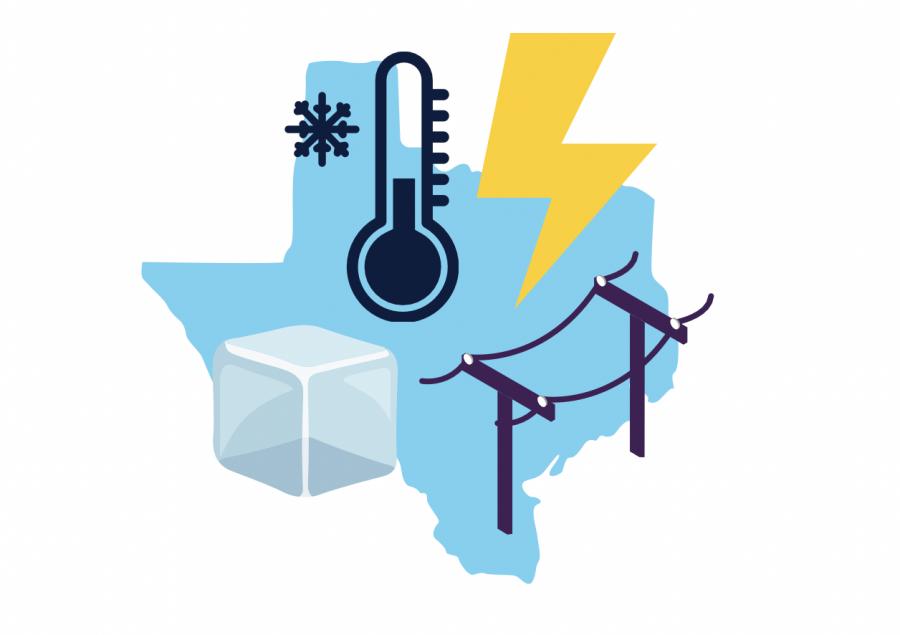The Crisis in Texas: What Really Happened?
Texas faced a combined crisis of extreme weather and electricity shortages.
In the early weeks of February, when most of the country was gearing up for Valentine’s and Presidents’ Day, Texas entered a crisis that would prove to be like no other. Frigid temperatures and icy conditions cumulated with an energy system breakdown, uncovering the faults and cracks within Texas’ power structure.
According to the National Weather Service, the city of Houston dipped to 13˚F, Galveston to 20˚F, and College Station to 5˚F, while freezing rain, snow, and sleet began to fall over much of the state. Needless to say, this was unprecedented weather for the Lone Star State.
“I’d be guessing, but probably it’s about 20 to 25 degrees in my house right now and getting colder,” New York Times National Energy Business Correspondent Clifford Kraus said in an interview on The Daily podcast.
A band of fast-moving wind, called a jet stream, that usually covers the North Pole bulged down and reached almost all of the continental U.S.. It brought supercooled polar air down and formed an “arctic outbreak,” according to Popular Science.
“Occasionally the hot air in the winter strongly pushes to the North Pole, which then displaces the very cold air in the Arctic. So the cold air in the Arctic will then go down over the continents in the Northern Hemisphere, which, you know, brings air much colder than typical,” OHS AP Environmental Science teacher Bryce Rasmussen said.
And while many will jump to the conclusion, it is unclear whether this event is directly linked to climate change.
“It’s hard to link one specific weather event to climate change…this event was probably enhanced by climate change. But it’s hard to say that it was caused by it,” Rasmussen said.
Following the severe weather were the numerous and grave power outages. Tens of millions were suddenly without power, in what would mark one of the largest blackouts in U.S. history. The reasoning behind this breakdown can be placed into three categories: the singularity of Texas’ grid, the deregulation of Texas’ power, and poor preparation.
Texas is the only state in the continental U.S. that has its own grid, meaning their power comes from and is distributed solely within their own borders. They have both the supply and demand to set themselves apart from the national grid, which worked well up until now.
“If you’re in North Dakota, and you’ve got a lot of wind and you’re producing a lot of wind energy, but you don’t have a big population, you’re going to send that energy through transmission lines to other states. If you are in New York, and you want hydro from Canada, you’re going to bring it down. Texas doesn’t need to do that. Texas has got the supply and demand within its own borders,” Krauss explained.
And not only does Texas have its own grid, but their entire power structure is deregulated; it’s a privatized, market-based patchwork of electricity generators. Due to this deregulation, there is heightened competition among the electricity providers. They try to be as cost-efficient as possible so that they can provide electricity at the lowest price, but they skip important facets such as weather protection and proper maintenance.
Texas is also ill-prepared for such a dire situation: power plants are not properly weatherized, wind turbines are not equipped with de-icing equipment, and power lives have little insulation. One of the reasons for this lack of infrastructure is that it is costly. According to PBS, winterizing only ⅓ of the total natural gas wells, for example, would cost over $1.75 billion.
“[Texas] had ample warning in 2011. They followed that up with a commission, and that commission recommended all of the weather fitting for the infrastructure that supplies energy. They just didn’t want to spend the money to do it,” OHS history and Political Science teacher Dave Herring said.
Their power equipment is not equipped to withstand the frigid temperatures that Texas experienced, which created an ultimate breakdown of the system.
“It seems like everything has gone wrong. There’s been a freezing up of at least some of the wind turbines. There’s been a freezing up of gas lines. There have been problems with the transmission even from the nuclear as well as coal plants. So across the entire supply chain, there are problems. And so it appears to be a system that is not prepared to deal with prolonged periods of cold,” Krauss said.
The aftermath of the Texas’ weather and power crisis is also quite severe. People struggled to stay warm, suffered extreme bouts of hypothermia, and even froze to death. According to AP News, roughly 70 deaths were attributed to the extreme weather nationwide. They also claimed that of the 12+ people who died in their homes that had lost heat, most were in Texas.
ERCOT, the Electric Reliability Council of Texas, also begins to face extreme backlash. ERCOT is a non-profit formed to manage the wholesale market and manage most of Texas’ power grid, and they are receiving much blame for a poor-handling of the situation. After receiving threats and accusations, many of the top board leaders recently resigned.
“When Texans were in desperate need of electricity, ERCOT failed to do its job and Texans were left shivering in their homes without power. ERCOT leadership made assurances that Texas’ power infrastructure was prepared for the winter storm, but those assurances proved to be devastatingly false. The lack of preparedness and transparency at ERCOT is unacceptable, and I welcome these resignations. The State of Texas will continue to investigate ERCOT and uncover the full picture of what went wrong, and we will ensure that the disastrous events of last week are never repeated,” Governor Greg Abbott said in a statement.
However, ERCOT does not stand alone in the blame. Abbott himself, as well as policy makers in Texas, are all receiving reverberations.
“The number one responsibility of government is to ensure the safety and security of its citizens. They just absolutely failed at their number one job,” Herring said.
The road to recovery for Texans will be lengthy and emotional. Hopefully Texas will learn from this catastrophe, working to restore the breaches uncovered by this crisis.





















































